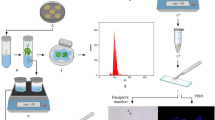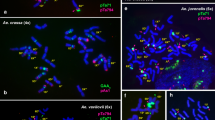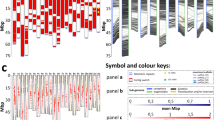Abstract
Evolutive studies have verified that Coffea arabica (2n = 44) is a natural segmental allopolyploid originated from a cross between two diploid (2n = 22) Coffea species. Data obtained by classical cytogenetic analyses showed that C. arabica chromosomes are small and morphologically similar, which hampers the karyogram assembly with well-identified homologue pairs. In the present study, the C. arabica complement was reanalysed using an improved cytogenetic protocol that allowed the obtention of high-quality prometaphasic and metaphasic chromosomes. The results showed that chromosomes are cytogenetically distinct (1, 2, 19, 20, 21 and 22) and identical (3–4, 5–6, 7–8, 9–10, 11–12, 13–14, 15–16 and 17–18), with regard to their total length, short and long arm sizes or chromosome classes. Our work suggests that C. arabica is a true non-segmental allotetraploid but originated from different species exhibiting similar and distinct chromosomes.

Similar content being viewed by others
References
Abreu IS, Carvalho CR, Clarindo WR (2008) Chromosomal DNA content of sweet pepper determined by association of cytogenetic and cytometric tolls. Pl Cell Rep. doi 10.1007/s00299-008-0539-4
Aggarwal RK, Hendre PS, Varshney RK, Bhat PR, Krishnakumar V, Singh L (2007) Indentification, characterization and utilization of EST-derived genic microsatellite markers for genome analyses of coffee and related species. Theor Appl Genet 114:359–372
Anthony F, Bertrand B, Quiros O, Wilches A, Lashermes P, Bertraud J, Charrier A (2001) Genetic diversity of wild coffee (Coffea arabica L.) using molecular markers. Euphytica 118:53–65
Baruah A, Naik V, Hendre PS, Rajkumar R, Rajendrakumar P, Aggarwal RK (2003) Isolation and characterization of nine microsatellite markers from Coffea arabica L., showing wide cross-species amplifications. Molec Ecol Notes 3:647–650
Berthouly M, Michaux-Ferriere NM (1996) High frequency somatic embryogenesis in Coffea canephora. Pl Cell Tiss Organ Cult 44:169–176
Bouharmont J (1963) Somatic chromosomes of Coffea species. Euphytica 12:254–257
Campa C, Doulbeau S, Dussert S, Hamon S, Noirot M (2005a) Diversity in bean caffeine content among wild Coffea species: evidence of a discontinuous distribution. Food Chem 91:633–637
Campa C, Doulbeau S, Dussert S, Hamon S, Noirot M (2005b) Qualitative relationship between caffeine and chlorogenic acid contents among wild Coffea species. Food Chem 93:135–139
Carvalho CR, Saraiva LS (1993) A new heterochromatin banding pattern revealed by modified HKG banding technique for maize chromosomes. Heredity 70:515–519
Carvalho CR, Saraiva LS (1997) High-resolution HKG-banding in maize mitotic chromosomes. J Pl Res 110:417–420
Charrier A, Berthaud J (1985) Botanical classification of coffee. In: Clifford MN, Wilson KC (eds) Coffee: botany, biochemistry and production of beans and beverage. AVI Publishing Company, Westport, Connecticut, pp 13–47
Clarindo WR, Carvalho CR (2006) A high quality chromosome preparation from cell suspension aggregates culture of Coffea canephora. Cytologia 71:243–249
Clarindo WR, Carvalho CR, Alves BMG (2007) Mitotic evidence for the tetraploid nature of Glycine max provided by high quality karyograms. Pl Syst Evol 265:101–107
Conagin CHTM, Mendes AJT (1961) Pesquisas citológicas e genéticas em três espécies de Coffea. Auto-compatibilidade em Coffea canephora Pierre ex Froehner. Bragantia 20:1–74
Freitas DV, Carvalho CR, Filho FJN, Astolfi-Filho S (2007) Karyotype with 210 chromosomes in guaraná (Paullinia cupana ‘Sorbilis’). J Pl Res 120:399–404
Galasso I, Schmidt T, Pignone D (2001) Identification of Lens culinaris ssp. culinaris chromosomes by physical mapping of repetitive DNA sequences. Chromosome Res 9:199–209
Guerra MS (1986) Reviewing the chromosome nomenclature of Levan et al. Rev Bras Genet 9:741–743
Höfling JF, Oliveira AR (1981) A serological investigation of some Coffea species with emphasis on the origin of C. arabica L.Ciência e Cultura 33:66–76
Krug CA(1934) Variações somáticas em Coffea arabica L. Instituto Agronômico de Campinas 12:1–11
Lashermes P, Cros J, Marmey P, Charrier A (1993) Use of random amplified DNA markers to analyse genetic variability and relationships of Coffea species. Genet Res Crop Evol 40:91–99
Lashermes P, Cros J, Combes MC, Trouslot P, Anthony F, Hamon S, Charrier A (1996) Inheritance and restriction fragment length polymorphism of chloroplast DNA in the genus Coffea L. Theor Appl Genet 93:626–632
Lashermes P, Combes MC, Trouslot P, Charrier A (1997) Phylogenetic relationships of coffee-tree species (Coffea L.) as inferred from ITS sequences of nuclear ribosomal DNA. Theor Appl Genet 94:947–955
Lashermes P, Combes MC, Robert J, Trouslot P, D’Hont A, Anthony F, Charrier A (1999) Molecular characterization and origin of the Coffea arabica L. genome. Molec Gen Genet 261:259–266
Lashermes P, Paczek V, Trouslot P, Combes MC, Couturon E, Charrier A (2000) Single-locus inheritance in the allotetraploid Coffea arabica L. and interspecific hybrid C. arabica x C. canephora. J Heredity 91:82–85
Levan A, Fredga A, Sanderberg AA (1964) Nomenclature for centromeric position in chromosome. Hereditas 52:201–220
Lopes CR, Cunha RA, Blotta LF (1984) Estudo taxonômico do gênero Coffea com emprego de métodos numéricos. Turrialba 34:421–430
Mahé L, Combes M, Lashermes P (2007) Comparison between a coffee single copy chromosomal region and Arabidopsis duplicated counterparts evidenced high level synteny between the coffee genome and the ancestral Arabidopsis genome. Pl Molec Biol 64:699–711
Mendes AJT (1938a) Morfologia dos cromossomos de Coffea excelsa Chev. Instituto Agronômico de Campinas. Boletim Técnico 56:1–8
Mendes AJT (1938b) Os cromossomios das Rubiáceas. Instituto Agronômico de Campinas. Boletim Técnico 56:1–11
Murata M (1983) Staining air dried protoplasts for study of plant chromosomes. Stain Technol 58:101–106
Orozco-Castillo C, Chalmers KJ, Waugh R, Powell W (1996) RAPD and organelle specific PCR re-affirms taxonomic relationships within the genus Coffea. Pl Cell Rep 15:337–341
Pinto-Maglio CAF (2006) Cytogenetics of coffee. Braz J Pl Physiol 18:37–44
Pinto-Maglio CAF, Cruz ND (1998) Pachytene chromosome morphology in Coffea L. II. C. arabica L. complement. Caryologia 51:19–35
Planchais S, Glab N, Inzé D, Bergounioux C (2000) Chemical inhibitors: a tool for plant cell cycle studies. FEBS Lett 476:78–83
Raina M, Mukai SN, Yamamoto Y (1998) In situ hybridization identifies the diploid progenitor species of Coffea arabica (Rubiaceae). Theor Appl Genet 97:1204–1209
Rijo L (1974) Observações cariológicas no cafeeiro ‘Híbrido de Timor’. Portugaliae Acta Biológica 8:157–168
Ruas PM, Ruas CF, Rampim L, Carvalho VP, Ruas EA, Sera T (2003) Genetic relationship in Coffea species and parentage determination of interspecific hybrids using ISSR (inter-simple sequence repeat) markers. Genet Molec Biol 26:319–327
Sharma AK, Sharma A (1999) Plant chromosomes: analysis, manipulation and engineering. Harwood Academic Publishers, Amsterdam
Singh RJ (1993) The handling of plant chromosomes. In: Singh RJ (ed) Plant cytogenetics. CRC Press, USA, pp 7–24
Stebbins GL (1947) Types of polyploids: their classification and significance. Adv Genet 1:403–429
Stebbins GL (1949) Variation and evolution in plants. Columbia University Press, New York
Sybenga J (1992) Cytogenetics in plant breeding. Monographs on theoretical and applied genetics 17. Springer, Germany
Van Boxtel J, Berthouly M (1996) High frequency somatic embryogenesis from coffee leaves. Factors influencing embryogenesis and subsequent proliferation and regeneration in liquid medium. Plant Cell Tiss Organ Cult 44:4–17
Acknowledgments
We thank the CNPq—Conselho Nacional de Desenvolvimento Científico e Tecnológico and CBP&D/Café—Consórcio Brasileiro de Pesquisa e Desenvolvimento do Café, Brazil, for their financial support.
Author information
Authors and Affiliations
Corresponding author
Rights and permissions
About this article
Cite this article
Clarindo, W.R., Carvalho, C.R. First Coffea arabica karyogram showing that this species is a true allotetraploid. Plant Syst Evol 274, 237–241 (2008). https://doi.org/10.1007/s00606-008-0050-y
Received:
Accepted:
Published:
Issue Date:
DOI: https://doi.org/10.1007/s00606-008-0050-y




